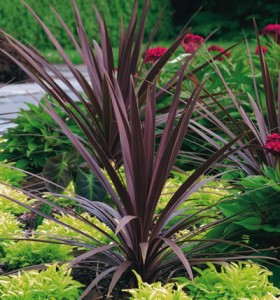Cordyline Growing Guide

What is Cordyline?
Cordyline (Cordyline spp.) also known as Palm Lilies, Cabbage Palms or Cabbage Trees is an upright hardy evergreen perennial. It is part of the Agavaceae family and is native to Australia, New Zealand, South America and South East Asia. There are 15 species of Cordyline, of which 8 are native to Australia. Others come from New Zealand and the South-West pacific region. One species originates from South America. Over the years there has been much hybridisation so there are many varying attributes. Cordyline are slow growing plants that are grown for their foliage. They come in a range of sizes and colours. Some of the colours you can find are greens, reds, pinks, oranges, browns and yellows. There are two main types of Cordyline, the tropical/subtropical ones and the warm to cool temperate ones. The tropical ones are suited for warm humid climates and come in all the flashy colours. In cooler climates these can be grown as an indoor plant. The warm to cooler temperate varieties are better suited for cooler climates and are usually hybrids of the Cordyline australis. All Cordylines should be protected from frosts. Some varieties prefer shade, while others are better in the sun. They flower late Spring into Summer with panicles of small creamy, white or pale pink flowers.
Benefits of Growing Cordyline
Cordyline can give year round lushness and colour in your garden. They make an excellent addition when planted en masse, used in a tropical garden setting or in pots or containers. They are a hardy plant that requires very little looking after once established. It tolerates salty coastal conditions and once established it will tolerate drought conditions.
How to Grow Cordyline
Climatic Zones
Some varieties are suited for cool to temperate areas while others will be suited for more tropical areas. Check individual varieties.
Plant Size
Sizes will vary.
When To Plant Cordyline
Plant anytime.
Soil Preparation
They are generally not fussy, but will thrive in rich, well-drained soils. Mix through compost or well broken down manure into the soil before planting.
Most Cordyline do not like wet feet so do not plant Cordyline in a wet position in the garden, plant in a raised garden bed or improve drainage.
How To Plant Cordyline
Plant in full sun to part shade, with the plant crown at soil level.
Cordyline Plant Care
Regular watering will keep these plants lush all year round. Increase watering during hot periods.
Fertilise with a controlled-release fertiliser in Spring. You can also fertilise with a fertiliser high in potassium (potash) which will give leaves a brighter colour.
Remove dead foliage and cut back in Spring if plants become leggy. Cut off spent flowers. Suckers that appear can be transplanted in Spring.
Cordyline can suffer from root rot if they remain too wet for too long.
Watch out for grasshoppers and snails.







